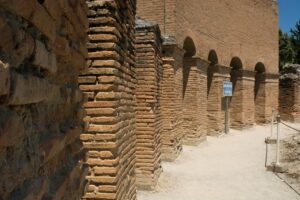To look at it now, you’d never know that Gortyn, or Gortyna, (or Gortys for that matter), was once the most prominent city in ancient Crete. In fact, from the outside, you wouldn’t think of it much except as a passing roadside attraction. I can’t say I took notice of it until I felt the car slowing down, and looking up I found myself in a parking lot that was most definitely not for the beach I thought we had been en route towards. I discovered, shortly, that though the place is unassuming from the outside, the archaeological site of Gortyna is not one to be missed.

Gortyna is now a small unassuming archaeological site that had been discovered in the later 1800s, but once it spanned so far and wide that it governed the whole southern-central part of Crete, including part of Rhethymnon. It was more important than even Knossos or Phaistos was at a time, and their Great Inscription, a summary of legal code that even today is considered advanced and complex, was a testament to their importance. Gortyna was a city of firsts, it seems: it was the first prosperous and powerful city in Crete during the Hellenistic era, the first Cretan city to fall under Roman rule, (including such updates as a new circular theater, a third agora, and a hippodrome), the first city to become an anchor to Christianity when Saint Titus preached there, and more. And yet today, a stroll through the grounds of Gortyna is less a trip back in time than it is a wander through a ghost town, where nature seems to have reclaimed the land that once was a great metropolis. Giant lizards scurried in and out of cracks and crevices while cats lounged lazily in the sun, as usual in places they probably shouldn’t have been, and in the undergrowth the hum of the insects set the perfect soundtrack to my exploration. I had no idea the importance of the place at the time, as the placards and information cards were limited. But the site had a weight to it, the sort of calm one experiences when walking through a town that was once alive. The shadows from the columns of the ancient Odeon engulfed me and whispered to me questions of who else had stepped into their shade, who had walked these halls before I had. Who had walked these worn dirt roads before me? Had the people who had built these columns, once so tall, foreseen their toppling? Had they known people would hop on and off ledges, through phantom walls into rooms that no longer existed? I thought about that as I stood in the center of what used to be a house, or maybe a store. I was never to find out.

Despite not knowing a bit of the history of the place before visiting, the heat of the day and the surroundings lent itself to dreams of when the city was in its prime, and it was easy to slip into the fantasy of wandering the streets of a busy Grecian city as the theater across the way performed its latest epic drama. I had heard that it was here Europa was finally seduced by Zeus, after he had whisked her away, and the three great kings of Crete were conceived under a plane tree that still stands. This fine line between myth and reality is so blurred in a place like Gortyna, where the facts are just obtuse enough to make one believe that anything was possible. So much was born in Gortyna: Roman influence, the root of Christianity in Crete and Greece…why not the royal sons of Zeus? Was it so impossible?
But of course, I haven’t even discussed their own unique wonder yet.

The most incredible part of Gortyna is the olive grove. I have never before had the pleasure of walking with trees that were there long before the existence of modern civilization. Trees that are some of the oldest in existence reside here, thick and worn and bent with age, but still strong and firm. Perhaps they’re a reflection of how the people age on Crete, growing stockier and more knobby, but never weaker, never less fascinating, never less beautiful. Imagine being able to reach out and touch a living thing that existed at a time when the ruins around you once stood tall. Imagine feeling the wind blowing through their leaves, the same wind that would have brushed against the faces of the ancient citizens, perhaps as they waited for the shops to open or a show to begin. Imagine placing your hand on the same bark that someone who existed before Christ himself placed his hand. It is a surreal and beautiful experience, this testament to living history. All at once you become a part of it, and a connection is forged between you and the rubble that surrounds you, the cicadas, the cats, the once great pillars and carved legal codes. All of it is connected and alive again, standing there in the olive grove.

A landscape reflected in its people is perhaps the most beautiful monument to civilization that stands today. I don’t think even the ruins would dispute this.
By Katarina Kapetanakis

